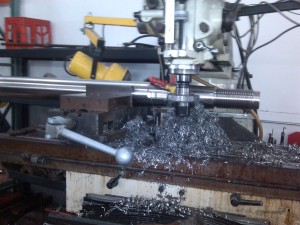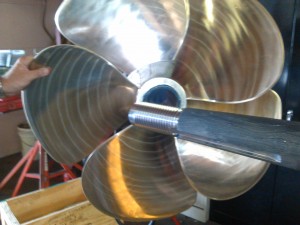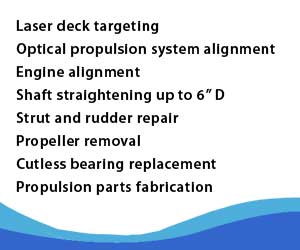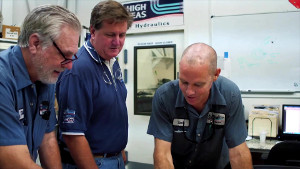Machining new AQUAMET 22 HS Shafts
We have been working on converting a 61 foot Blackwell “Carolina” Sport Fish’s shaft system back to its original configuration from an Oil Bath Shaft System. Along the way we have published a couple of posts on the steps we have taken to accomplish this task.
The final step to complete the job involved machining new Aquamet 22 H.S. shafts. AQUAMET 22 is a high-alloy austenitic stainless steel that provides superior corrosion resistance along with excellent toughness and high strength. The H.S. is a higher strength version of the material and is available in 2-1/2” to 6” diameters. For this boat, the shaft was 3-1/4” in diameter.
Part of the process involved machining the coupler and prop tapers and keyways. We caught the machine shop as they were finishing the final prop keyway and lapping propellers. The key is a machine element used to connect a rotating machine element to the shaft. The key prevents relative rotation between the two parts and may enable torque transmission. For a key to function, the shaft and rotating machine element must have a keyway and a keyseat, which is a slot and pocket in which the key fits. The whole system is called a keyed joint. A keyed joint may allow relative axial movement between the parts.
Once completed, we lapped the propeller to the shaft. This was particularly important since the vessel purchased brand new Veem propellers that had never been seated on a shaft. When shafts are in the machine shop, you should have the props and couplers lapped onto the shaft. Lapping is the process of using a gritty paste between the two surfaces to allow them to grind together for a perfect fit. We prefer to lap while the shaft is in the lathe in order to take advantage of the shaft spinning and the overhead hoist to hold the heavy props and couplers.
Lapping the bore of the prop/coupler to the shaft taper ensures a 90-100% fit between the surfaces. If you are installing new propellers or shafts, this process becomes even more important. It is not uncommon to find a prop or coupler bore that is only touching in certain high points on the taper. A poor fit can cause the prop to be slightly off balance on the shaft. A poor fit with low contact is also more likely to become a loose prop at some point in time.
By performing the lapping process, we can provide a perfect tapered fit and a smooth ride for the future.




 Click to watch the video of a day at High Seas Yacht Service.
Click to watch the video of a day at High Seas Yacht Service. Click to watch Marine Industries Association of South Florida video featuring Salty Jobs at High Seas Services.
Click to watch Marine Industries Association of South Florida video featuring Salty Jobs at High Seas Services.
Comments are closed.